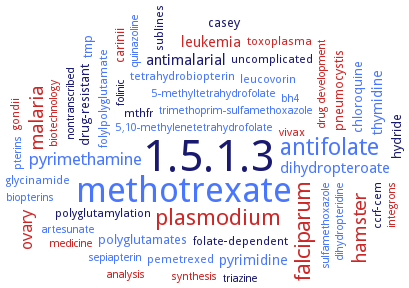1.5.1.3: dihydrofolate reductase
This is an abbreviated version!
For detailed information about dihydrofolate reductase, go to the full flat file.

Word Map on EC 1.5.1.3 
-
1.5.1.3
-
methotrexate
-
antifolate
-
plasmodium
-
falciparum
-
hamster
-
malaria
-
pyrimethamine
-
ovary
-
antimalarial
-
leukemia
-
dihydropteroate
-
thymidine
-
pyrimidine
-
carinii
-
polyglutamates
-
pneumocystis
-
hydride
-
chloroquine
-
casey
-
drug-resistant
-
tmp
-
ccrf-cem
-
vivax
-
glycinamide
-
toxoplasma
-
uncomplicated
-
folate-dependent
-
mthfr
-
folylpolyglutamate
-
pemetrexed
-
sublines
-
leucovorin
-
tetrahydrobiopterin
-
polyglutamylation
-
gondii
-
nontranscribed
-
sulfamethoxazole
-
trimethoprim-sulfamethoxazole
-
quinazoline
-
5-methyltetrahydrofolate
-
sepiapterin
-
integrons
-
dihydropteridine
-
analysis
-
medicine
-
artesunate
-
synthesis
-
triazine
-
folinic
-
5,10-methylenetetrahydrofolate
-
bh4
-
biotechnology
-
biopterins
-
drug development
-
pterins
- 1.5.1.3
- methotrexate
- antifolate
- plasmodium
- falciparum
- hamster
- malaria
- pyrimethamine
- ovary
-
antimalarial
- leukemia
- dihydropteroate
- thymidine
- pyrimidine
- carinii
- polyglutamates
- pneumocystis
-
hydride
- chloroquine
-
casey
-
drug-resistant
- tmp
-
ccrf-cem
- vivax
- glycinamide
- toxoplasma
-
uncomplicated
-
folate-dependent
- mthfr
- folylpolyglutamate
- pemetrexed
-
sublines
- leucovorin
- tetrahydrobiopterin
-
polyglutamylation
- gondii
-
nontranscribed
- sulfamethoxazole
- trimethoprim-sulfamethoxazole
- quinazoline
- 5-methyltetrahydrofolate
- sepiapterin
- integrons
- dihydropteridine
- analysis
- medicine
- artesunate
- synthesis
-
triazine
-
folinic
- 5,10-methylenetetrahydrofolate
- bh4
- biotechnology
- biopterins
- drug development
- pterins
Reaction
Synonyms
5,6,7,8-tetrahydrofolate: NADP+ oxidoreductase, 7,8-dihydrofolate reductase, At2g16370, At4g34570, bifunctional dihydrofolate reductase-thymidylate synthase, bifunctional TS-DHFR, BmDHFR, dehydrogenase, tetrahydrofolate, DFR-TS, DFR1, DfrA, DfrB, DHFR, DHFR type IIIC, DHFR-TS, DHFR-TS1, DHFR-TS2, DHFR2, DHFRL1, DHFRLS, dihydrofolate reductase, dihydrofolate reductase-like, dihydrofolate reductase-thymidylate synthase, dihydrofolate reductase:thymidylate synthase, dihydrofolic acid reductase, dihydrofolic reductase, EC 1.5.1.4, ecDHFR, folA, folA3, folic acid reductase, folic reductase, FolM, hDHFR, hDHFR-1, hDHFR-2, HjDHFR, hvDHFR1, hvDHFR2, LAU_0427, LBRM_06_0830, mDHFR, mjDHFR, More, myDHFR, NADPH-dihydrofolate reductase, pcDHFR, PKNH_0509600, ppDHFR, pteridine reductase, pteridine reductase:dihydrofolate reductase, PTR2, R-plasmid-encoded dihydrofolate reductase, R67 DHFR, R67 dihydrofolate reductase, reductase, dihydrofolate, S3DHFR, Smdhfr, Smp 175230, spDHFR, svDHFR, tcptr1, tetrahydrofolate dehydrogenase, THY-1, THY-2, thymidylate synthase-dihydrofolate reductase, thymidylate synthetase-dihydrofolate reductase, Trimethoprim resistance protein, TS-DHFR, WUBG_00817


 results (
results ( results (
results ( top
top





